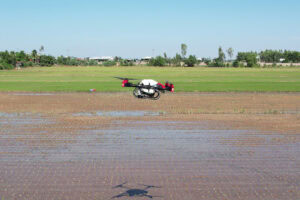Vietnamese farmer adopts drones in rice farming

62-year-old Vietnamese farmer Le Thanh Nguyen is one of the earliest farmers in Vietnam to adopt agricultural drones in rice production.
Le Thanh Nguyen grows rice in the Tam Nong District of the Dong Thap Province. Over the past 40 years, he has been farming in the traditional way. Recently however, the Vietnamese grower decided to use drones, spurred on by an ever-increasing labour shortage.
Labour issues

Like many other farmers, Le Thanh Nguyen used to have difficulties hiring workers for manual jobs. During the busy rice season, his workers were supposed to come in the early morning to sow seeds for his rice field, but very often they arrived at the late afternoon. By that time, the seeds had germinated, and the shoots were easily broken during spreading and therefore caused yield loss.
And when his workers did arrive on time, Le was often not satisfied with the results of seeding by hand or spreader. The seeding wasn’t done precise enough and as a result, the plant density was not optimal.
XAG P100 drone
In 2021 Le Thanh Nguyen first learned about drones through DigiDrone, a Vietnamese partner of Chinese drone manufacturer XAG. After witnessing the possibilities, he decided to invest in the technology. A XAG P100 drone is now being used for crop spraying, fertilising and seeding.

“The drone eases the burden and greatly improves the efficiency. In the past, I had to pay 4 workers to carry and spread 1 ton of fertilisers on my field from 6 am to 2 pm and they were exhausted after that. Now with the latest XAG P100 agricultural drone, spreading one ton of fertiliser only takes an hour to finish with even spreading results,” he said.
Less inputs
According to Le Thanh Nguyen he is also saving money. Although he hires a drone pilot, he doesn’t have to pay other workers anymore, and he uses less inputs. “Seeding 1 hectare requires 120 kg of rice seeds when the drone is used. In order to get the same yield with manual seeding, I needed 150 to 200 kg of seeds. Also, with the drone no damage is done to the crops during spraying and fertilising, so my yield increases,” he concludes.
Join 17,000+ subscribers
Subscribe to our newsletter to stay updated about all the need-to-know content in the agricultural sector, two times a week.



